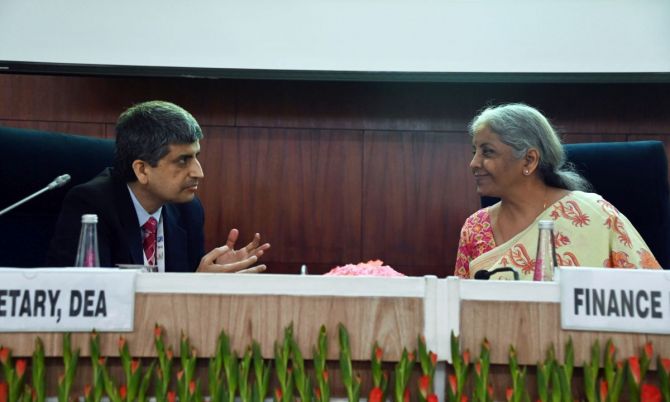'They have started becoming an important player, but not at the same level as they were in the earlier part of the decade.'

"Private investments are significant in the infrastructure sectors, such as telecom, ports and airports, and large scale housing projects. So, government and private capex are complementing each other," Economic Affairs Secretary Ajay Seth tells Arup Roychoudhury and Asit Ranjan Mishra/Business Standard.
What is the main thinking, key drivers behind the FY24 Budget?
I will put it in three elements.
One, we should continue to support growth. In the pandemic years, we had the loss of output, which we have to make up for. We need to grow faster so we have strong impetus to grow.
Second, it has to be done in a manner that we are fiscally prudent, especially in the context of very high degree of uncertainty at the global level.
Third, not to keep our eyes off what is needed for the long term for the potential of the economy, in terms of its productive capacity, for getting skills to the people, so that they have the right set of skillsets when job opportunities grow.
So, these are the three aspects -- growth, fiscal prudence, and the long-term investment in softer aspects of the economy, such as skilling and productivity.
The Budget has assumed a nominal GDP growth of 10.5 per cent in FY24. What sort of real GDP growth are you looking at?
When we talk about nominal, it is a combination of deflator and real growth rate. The Economic Survey gives a range of 6-6.8, with probability it being towards the higher level of that range. We share that assessment.
Our sense is that growth will be 6.5 per cent-plus in FY24. That means a deflator of 4 per cent. Wholesale and retail inflation are cooling down.
If inflation were to go down further, that would boost growth further.
Revenue deficit is expected to come down sharply in FY24. For some years, it seemed like the finance ministry had abandoned efforts to bring down the revenue deficit.
Are we now again targeting to eliminate the revenue deficit as initially planned under the FRBM Act?
For the foreseeable future, it will not be appropriate for us to make that assumption that revenue deficit will be eliminated. That is a goal for state governments.
But given that a large set of responsibilities are with the Government of India, the idea is we should be at a moderate level. What is more relevant is the primary deficit.
A very clear signal that has come in the last 3-4 years is that fiscal consolidation should not be at the cost of capital expenditure.
Even in capital expenditure, the private sector is the main driver, but the government cannot be away from action when the private sector is not firing at its 100 per cent.
They have started becoming an important player, but not at the same level as they were in the earlier part of the decade.
Though the value may not have been decided, will we definitely see issuance of green bonds in FY24?
That decision has to be taken when we decide the calendar for the second half of FY24. We are not planning it in the first half of FY24 because the money that is being raised in January and February, in terms of an unwritten compact with those investors, needs to be used first. The money we are raising will suffice for the next 6-9 months.
While you have a medium-term road map, there is criticism that unless the Fiscal Responsibility and Budget Management Act is amended, there is no official consolidation road map. It has been three years now.
When can we expect the Act to finally be amended?
FRBM is a long-term commitment. At this point of time, the commitment is to reach below 4.5 per cent by FY26. We have a clear path and a goal for the next three financial years. By that time, one has to take a decision on the road map beyond that. We don't expect it to take that long.
But once the global headwinds are stabilised, the FRBM Act will be amended. The current uncertainty makes it a difficult call to make long-term commitments.
What is the debt-to-GDP ratio you see in FY24?
We are at 57 per cent of GDP for the central government, we have to see that every year we nibble away may be a percentage point. Most of the increase happened in FY21 when the government had to borrow a lot and at the same time there was a contraction in the economy. It will be a medium-term haul.
How do you measure the efficacy of the central government's capex on the ground?
There are numbers, which are analysed well when we say so many kilometres of railway lines are electrified, so many Vande Bharat trains are introduced or so many kilometres of roads are completed. These are numbers that are relevant for us to see the output.
We are no longer in the era where we say so much input has gone in. We have certainly moved into output and outcome.
I won't say we are at a stage where we are looking at the impact. That is a little longer term and difficult to measure, but certainly in terms of output, clearly visible signs are there and also in terms of outcome.
Do you believe private sector capex is not pulling in spite of whatever private sector balance sheets have shown?
I will request you to look at it in a more nuanced manner where government and private capex is going.
Government capex is going into railways, roads and urban infrastructure. These are sectors where 90 per cent-plus of the investment anyway is happening because of public investment, not because of private investment. Those are the investments that are needed, whether we do it today or over a number of years.
Private investments are significant in the infrastructure sectors, such as telecom, ports and airports, and large scale housing projects. So, government and private capex are complementing each other.
On the interest-free capex loans to states, is there a fear that it may substitute the capex that states should themselves bring to the table?
I will go by what has been the experience in the current financial year till November. Majority of states, about 60 per cent, use that money to augment their own capex while around 40 per cent have not used that opportunity. But moving forward in the next year, we expect that most states will use it in that manner.
Where are we with plans to include Indian sovereign bonds in global bond indices?
The global interest rates are going through a period of uncertainty. So far, our general stance is that public debt is to be largely financed out of domestic savings, and that stance remains very firm.













 © 2025
© 2025